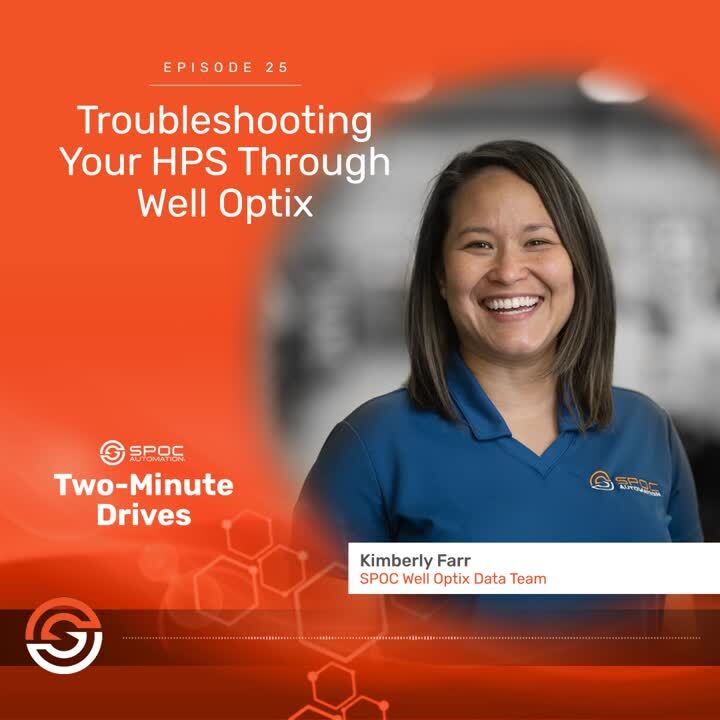
uNdZGXDWRf3vF4hKHVox4J
Transcript
Hey, guys. It’s Kimberly Farr with SPOC Automation. Today’s Two-Minute Drive is going to focus on troubleshooting your HPS system through Well Optix.
So, some of the values that our companies with H-pump systems are monitoring pretty regularly are the bearing temperature, suction pressure, discharge pressure and vibration. And then on a field level, they’re looking at the flow rate.
If they have a tank battery, they’re looking at tank levels — especially if it’s connected to the pipeline. For today’s purposes, I’ve pulled up a trend report from one of our customers who was making some equipment changes. I’ll go through each value with you guys and then show you where the problem occurred and how Well Optix was helpful in solving what was wrong at the field site.
So, if you look at the screen, you are looking at (in purple) the suction pressure and (in green) the discharge pressure. You’ve got the output frequency in red, and then, in black, I’m showing you the vibration. And this is their main trend. This is what they look at when they pull up Well Optix every day. Let’s see. I’m going to focus on the purple, because that’s where the problem actually lies.
The purple is your suction pressure again. Notice that at the beginning of the day, it looks like everything’s running pretty normally. Like I mentioned before, they made some equipment changes here, so they’re kind of tweaking the system a little bit. So, you’ll see a little bit of up and down, but at around 11:30 a.m., this is where they’re trying to make some changes.
And then at around, let’s say, 2:30 p.m., they shut the system down just to make sure that they made some changes with the system off. And then about 15 minutes later, you’ll notice everything comes back up; all the values show back up.
Well, we’re focused on the suction pressure, because the suction pressure actually never comes back up. It hits zero, and it stays there. Well, for the suction pressure to be at zero, that’s actually a critical fault. So, the guys who were in the field got an LED notification up on the drive that there was a critical fault. Well, the guys who were not at the field site, who were actually on the roster, received a text notification, a text alarm that there was something wrong at the field site. And when they pulled up Well Optix, they were able to get this trend and see the suction pressure was at zero. And this is where they were able to work with the field guys to kind of troubleshoot and see what the scenario was at the site. So, while they were looking at their trend, they noticed that all the other values seemed to be correct.
If you go back to before they shut down the system, notice that the suction pressure is at 47 PSI, and the vibration is at .16. So, they went back to where they turned the system back on. There are several things that could be critically wrong with the equipment. The transducer might have failed. They could have had a feeder valve fail, or it could be as simple as wires being crossed.
Well, somebody looking at this trend noticed that the vibration had actually gone up to .46. So, while they were in their office, they were talking to the guys in the field and said, “Hey, I think that the analogs have been swapped for both the vibration and the suction pressure.”
And that was the problem. So, they were able to switch it back. Now, they didn’t do it immediately. Notice that it remains at zero for quite some time. They ended up doing it the next day. I’m not going to pull up the rest of this trend. It looks better in the screen this way.
But they were able to fix this issue. And luckily, it was not a very costly issue, as it could have been. So that’s how they used Well Optix. They were able to work with the field team and make sure that everything was working properly again without having to leave their office. I’d love to show you more demonstrations of how Well Optix can help you troubleshoot your field. If you’re interested, please feel free to reach out to one of our SPOC team members or to me. Thank you.



